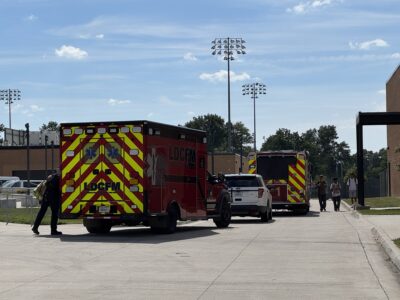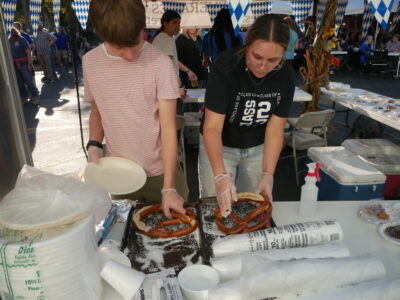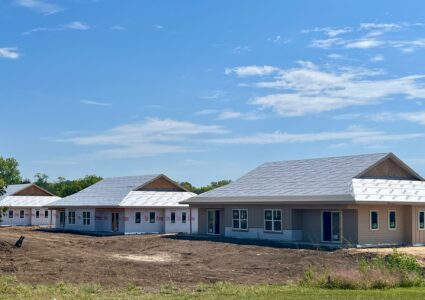Bishop Seabury graduate’s film on redlining and Kansas City jazz was screened in Smithsonian showcase, just won another national honor

photo by: Contributed
Mia Rasmussen, a former student at Lawrence's Bishop Seabury Academy, earned multiple accolades for a short film about Kansas City's jazz scene. She'll be honored Sunday afternoon in Chicago after she won the Latest Generation Film Contest run by the Lincoln Presidential Foundation.
When she was younger, listening to jazz music with her dad on the way to school in Lawrence, Mia Rasmussen knew that just a short drive away, Kansas City had a thriving jazz scene that became world famous.
But she did not know why it was centered on just one place: 18th and Vine.
In 2023, when her 11th grade history teacher at Bishop Seabury Academy, a private school in Lawrence, had assigned the entire grade to work on a National History Day project — a yearlong academic competition focused on historical research, interpretation and creative expression — she combined her creative side and interest in history to tell a story about Kansas City jazz.
At first, the project was just going to be about the various musicians and unique style of jazz that developed there. But when she wanted to understand why exactly the music scene was centered on one location, she learned about how the neighborhoods were “redlined” — a process which mapped out neighborhoods based on insurance risk that deemed predominantly Black areas as high risk for loans, leading to housing discrimination and segregating cities.
That realization was an “aha moment” for Rasmussen, and she decided to weave together the narratives of how redlining worked and how the Black community and jazz scene thrived. Her documentary, “Kansas City Jazz: A Frontier for Black Success,” was selected to represent the state of Kansas in the Smithsonian showcases that summer, with staff at the National Museum of African American History and Culture selecting her film to be showcased in the Oprah Winfrey theater at the museum, as the Journal-World reported.
Rasmussen, who now is studying filmmaking in college, earned another honor for her documentary this year, where it won first place in the Latest Generation Film Contest run by the Lincoln Presidential Foundation. Along with a cash award of $2,000, Rasmussen got to travel to Chicago for a red carpet event and screening of her documentary, with will take place Sunday afternoon.
Rasmussen sees documentary making as a way to tell important stories that can still shape people’s lives.
“I think it’s important to learn about local history because it provides context for now,” Rasmussen said.
Although this was the first project that won Rasmussen any accolades, it is not the first short film Rasmussen has worked on about history. She said in seventh grade, she completed a National History Day project about Amelia Earhart — visiting the famed aviator’s former house in Atchison, Kansas. Rasmussen said that project was where her fondness for documentary making started since it combined two of her interests: art and history.
“I always wanted to be creative but I wanted to use the analytical and history side,” Rasmussen said. “I think documentaries are the perfect avenue for that.”
When Rasmussen started work on the Kansas City Jazz documentary, she credited her history teacher, Sonja Czarnecki, as providing a lot of help and support.
Czarnecki, a history teacher at Bishop Seabury, said that every student at the school completes a National History Day project in seventh, ninth and 11th grades based on a different theme each year. In 2023, the theme was “Frontiers: People, Places, Ideas.”
Along with helping students use online resources to find primary and secondary sources for their projects — which can be a paper, website, exhibit, performance or documentary — Czarnecki said she took 11th graders to the University of Kansas’ Watson and Spencer Libraries to get more access to scholarly works.
Czarnecki told the Journal-World that Rasmussen’s project stood out to her not just because of the outstanding research, but her skill in videography, graphics, and animation as well. While highlighting the growth of the nightlife scene, Rasmussen recreates a sense of what the clubs would look like, complete with the Kansas City-style jazz music. At the first mention of redlining, she draws a red line across the screen that transitions the scene to discuss the details of the process. Czarnecki said the animation work highlights how skilled Rasmussen is at her craft.
“Her approach was scholarly and so totally unique from a design perspective,” Czarnecki said. “More and more professional documentarians have been including graphics and animation in historical works — Mia is right there with them.”
As Rasmussen began to dive into the issue of redlining, she said Czarnecki advised her to look through Mapping Inequality, a project by the University of Richmond that puts information on redlining in one database. As shown in her documentary, Rasmussen found the area surrounding 18th and Vine shaded red, and a description of the area called it “a typical colored area, ragged in every respect.”
Rasmussen contrasts that to the developments of JC Nichols, who built houses in the Country Club area around Kansas City. Those houses had covenants that included a restriction stating none of the lots “may be conveyed to, used, owned, nor occupied by negros as owners or tenants.”
Rasmussen said the discrimination “was there, plain as day” and it showed how this type of decision “builds systemic racism” where you can still see the impacts. Later in the short film, Rasmussen talks about how residents in previously redlined neighborhoods have less access to high-paying jobs and public transportation, receive less government money and have fewer parks — highlighting how the effects still linger.
“Where they are living was set up by people years ago,” Rasmussen said.
But Rasmussen also tells the story of how redlining couldn’t stop the rise of Black culture and jazz in Kansas City. Even with the systemic discrimination, the jazz scene became an avenue for success for Black Kansas Citians and created a community.
The accolades that Rasmussen earned for her project helped reaffirm her desire to continue exploring her passion in making documentaries. Rasmussen is a rising sophomore at Chapman University’s Dodge College of Film and Media Arts, where she is majoring in broadcast journalism and documentary filmmaking.
Although she’s now made many other broadcast-style news packages and short films as part of her school work, Rasmussen said while away at college, she got an email from Czarnecki suggesting she enter her Kansas City jazz documentary into the Lincoln Presidential Foundation contest.
Rasmussen said she “tinkered with it” a little bit, adding more animations and cutting the time for the documentary. She also enjoyed revisiting the film, thinking about what things she would have done differently after a year at college.
In addition to the awards she earned, Rasmussen said she appreciates the opportunity to meet other creators and filmmakers through this event and hopes she can get inspiration for other projects.
In fact, right after she is in Chicago, Rasmussen said she is traveling to Montana to work on a documentary with one of her friends, and she is planning to work on a documentary with other students in California that explores the relationship between the native Acjachemen Tribe and the San Juan Capistrano Mission ahead of next year’s 250th anniversary of the founding of the mission.
With a busy summer and eyes on continuing to create documentaries, Rasmussen said she is excited to continue learning more about the filmmaking process, including taking production classes and being a member of the college’s “Doc Club.” As she continues to grow as a filmmaker, Rasmussen said she is excited to keep exploring new subjects in documentaries and telling those stories.
“Pretty much all art comes from somewhere; there’s reasoning behind it all,” Rasmussen said. “If you look into anything, you can probably find it.”







